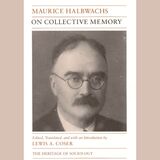
The Comparative Anatomy and Histology of the Cerebellum was first published in 1970. Minnesota Archive Editions uses digital technology to make long-unavailable books once again accessible, and are published unaltered from the original University of Minnesota Press editions.
This is the second volume of the late Dr. Larsell's comprehensive monograph on the cerebellum, the first volume of which is described below. A third volume, on the human cerebellum, will be published by the University of Minnesota Press next spring to complete the work.
This second volume deals with the morphogenetic development and morphology of the cerebellum of all orders of mammals from monotremes through apes. The descriptions cover the cerebellum in about forty species with special emphasis on the cerebellum of the albino rate, rabbit, cat, and rhesus monkey. Dr. Larsell's comparative anatomical studies over a period of many years led to the conclusion that fundamentally the mammalian cerebellum is composed of ten subdivisions. With few exceptions (the smallest and most primitive cerebella) the subdivisions are identified in all mammals. The descriptions of the cerebella are based on the author's personal investigations but the relevant literature is thoroughly reviewed also.

The Comparative Anatomy and Histology of the Cerebellum was first published in 1972. Minnesota Archive Editions uses digital technology to make long-unavailable books once again accessible, and are published unaltered from the original University of Minnesota Press editions.
This is the third and final volume of the late Dr. Larsell's definitive work on the cerebellum, brought to completion for publication by Dr. Jansen. Two additional contributing authors for this volume are Enrico Mugnaini, M.D., and Helge K. Korneliussen, M.D.
The first section of this volume deals with the morphology of the human cerebellum. The morphogenetic development, the fissure formation, and the differentiation of the cerebellar lobules are described in detail, and followed by a comprehensive account of the adult cerebellum, its lobes and lobules. It is shown that the ten major lobules which Dr. Larsell distinguished in other mammals are recognizable also in man.
Chapters on the cerebellum connections include detailed accounts of all afferent and efferent cerebellar tracts. A subsequent chapter, by Drs. Jansen and Korneliussen, is devoted to the fundamental plan of cerebellar organization. The final chapters, by Dr. Mugnaini, deal with the histology and cytology of the cerebellar cortex. A comprehensive account is given of electron micrographs, a virtual atlas of the ultrastructure of the cerebellar cortex, illustrate the description.


Committed to internationalism, Kazakhstan and other central Asian states nevertheless embrace classically nationalist conceptions of the nation-state. Their unabashed celebration of borders and citizenship challenges Western views of nationalism as a dying ideology transcended by cosmopolitanism. Drawing on twenty years of fieldwork, Central Peripheries reveals the origin of central Asian national consciousness in imaginary and ritualized efforts to grapple with the Soviet past.

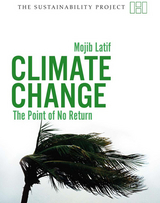

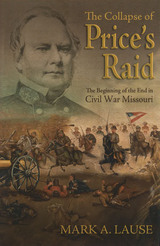


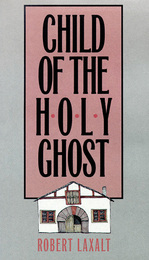
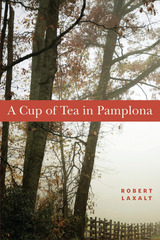
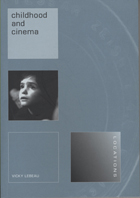


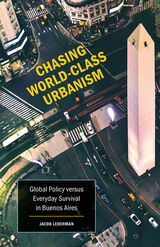
Questions increasingly dominant urban planning orthodoxies and whether they truly serve everyday city dwellers
What makes some cities world class? Increasingly, that designation reflects the use of a toolkit of urban planning practices and policies that circulates around the globe. These strategies—establishing creative districts dedicated to technology and design, “greening” the streets, reinventing historic districts as tourist draws—were deployed to build a globally competitive Buenos Aires after its devastating 2001 economic crisis. In this richly drawn account, Jacob Lederman explores what those efforts teach us about fast-evolving changes in city planning practices and why so many local officials chase a nearly identical vision of world-class urbanism.
Lederman explores the influence of Northern nongovernmental organizations and multilateral agencies on a prominent city of the global South. Using empirical data, keen observations, and interviews with people ranging from urban planners to street vendors he explores how transnational best practices actually affect the lives of city dwellers. His research also documents the forms of resistance enacted by everyday residents and the tendency of local institutions and social relations to undermine the top-down plans of officials. Most important, Lederman highlights the paradoxes of world-class urbanism: for instance, while the priorities identified by international agencies are expressed through nonmarket values such as sustainability, inclusion, and livability, local officials often use market-centric solutions to pursue them. Further, despite the progressive rhetoric used to describe urban planning goals, in most cases their result has been greater social, economic, and geographic stratification.
Chasing World-Class Urbanism is a much-needed guide to the intersections of culture, ideology, and the realities of twenty-first-century life in a major Latin American city, one that illuminates the tension between technocratic aspirations and lived experience.
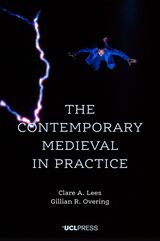
Speculative and nontraditional, The Contemporary Medieval in Practice adapts the conventional scholarly essay to reflect its interdisciplinary subject. Creative critical writing encourages the introduction of dialogue, poetry, and short essays within scholarly style, and this, the authors argue, makes it an ideal format for exploring innovative pathways from the contemporary to the medieval. Discussing urgent critical discourses and cultural practices, such as the study of the environment and the ethics of understanding bodies, identities, and histories, this short, accessible book focuses on early medieval British culture, or Anglo-Saxon studies, and its relation with, use of, and reworking in contemporary visual, poetic, and material culture after 1950.
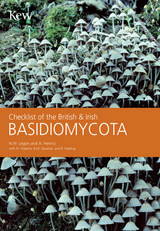
An essential companion for amateur and professional mycologists, and a valuable reference tool for all wildlife recorders, ecologists and conservationists.
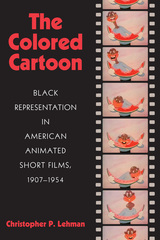
The first American animators drew on popular black representations, many of which were caricatures rooted in the culture of southern slavery. During the 1920s, the advent of the sound-synchronized cartoon inspired animators to blend antebellum-era black stereotypes with the modern black cultural expressions of jazz musicians and Hollywood actors. When the film industry set out to desexualize movies through the imposition of the Hays Code in the early 1930s, it regulated the portrayal of African Americans largely by segregating black characters from others, especially white females. At the same time, animators found new ways to exploit the popularity of African American culture by creating animal characters like Bugs Bunny who exhibited characteristics associated with African Americans without being identifiably black.
By the 1950s, protests from civil rights activists and the growing popularity of white cartoon characters led animators away from much of the black representation on which they had built the medium. Even so, animated films today continue to portray African American characters and culture, and not necessarily in a favorable light.
Drawing on a wide range of sources, including interviews with former animators, archived scripts for cartoons, and the films themselves, Lehman illustrates the intimate and unmistakable connection between African Americans and animation.Choice

Contemporaries of Carroll D. Wright (1840-1909) lived through the transformation of American society by the industrial revolution. For the most part they thought the transformation represented growth and progress, but many also found occasion for doubt and fear in its consequences. Their anxieties collected around the notions of a "labor problem" and "labor reform." Whether from hope or fear, people felt a need for statistical information. On this popular demand Wright built his career as statistical expert and renowned master of "labor statistics." His investigations during thirty-two years of government service (1873-1905) gave form to contemporary ideas and set precedents for modern procedures, as in his seminal studies of wages, prices, and strikes.
In telling how Wright took up this unprecedented career, Mr. Leiby shows the importance of Wright's early years and relates his work to the politics and religion of his time as well as to its social science. In this perspective, the history of the labor bureaus and their voluminous reports take on their original human purposes and meaning.
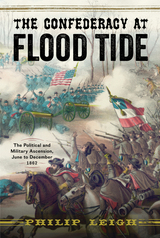
The first six months of 1862 provided a string of Federal victories in the West at Mill Springs, Fort Donelson, Pea Ridge, Island Number 10, and Shiloh. In May, New Orleans fell, and Union General George McClellan’s army was so close to the Confederate capital of Richmond, Virginia, that the troops could set their watches by the city’s church bells. But then the unexpected happened. In June, Robert E. Lee’s Army of Northern Virginia pushed McClellan’s much larger army back to the James River. In Europe, Confederate diplomats sought international recognition for the Confederate States of America, which was made even more attractive now that a shortage of cotton made the powerful textile interests anxious to end the war. Further tipping the balance, in July, the Confederacy secretly ordered two of the latest ironclad ships from England’s famous Laird Shipyard—the same yard that built the commerce raider Alabama. These steam-powered ironclads would be far superior to anything in the Federal navy.
While the “high tide” of the Confederacy is often identifed as Pickett’s Charge during the Battle of Gettysburg in July 1863, the most opportune time for the Confederacy vanished seven months earlier, coinciding with President Abraham Lincoln’s Emancipation Proclamation on January 1, 1863 and the failure of the secessionist states to be recognized as a sovereign nation. As Philip Leigh explains in his engrossing new book, The Confederacy at Flood Tide: The Political and Military Ascension, June to December 1862, on every battlefront and in the governmental halls of Europe, the Confederate effort reached its furthest extent during the second half of 1862. But with the president’s proclamation, battlefield reverses, Europe's decision to reject Confederate diplomatic overtures, and Britian's decision to halt the sale of the ironclads, the opportunity for Confederate success ended. The Confederacy would recede, and the great battles of 1863 and 1864 only marked the Southerners’ tenacity and stubborn belief in a lost cause.
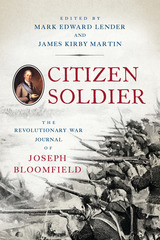
“About sunset we made a stand, when I was wounded, having a Ball with the Wad shot through my left forearm & the fuse set my coat and shirt on fire.” So wrote Major Joseph Bloomfield in his journal on September 11, 1777, describing his experiences during the hard-fought battle of Brandywine. Bloomfield was an officer in the 3rd New Jersey Regiment from 1776 to 1779. His service took him from Fort Stanwix to Fort Ticonderoga in New York, to the battle of Brandywine in Pennsylvania, and to the battle of Monmouth in his native state. He later served as governor of New Jersey from 1801 to 1812. A compassionate officer admired by his men, Bloomfield carefully recounted the hardships of military campaigns—the swings of morale, the shortage of supplies, the ever-present illnesses—and the intensity of combat. Of special interest are Bloomfield’s important notes on the culture and behavior of the Iroquois tribes known collectively as the Six Nations, which played a crucial role in revolutionary New York.
Unpublished and all but unknown when the first edition—skillfully edited by historians Mark Edward Lender and Joseph Kirby Martin—appeared, Bloomfield’s wartime journal was praised for providing both scholars and general readers with new information on the Continental soldier; the revolution’s impact on society; warfare in New York, New Jersey, and Pennsylvania; and the motives and actions of the revolutionary generation. Soldiers and civilians, Patriots and Tories, come alive in this fascinating eyewitness narrative. This new edition of Citizen Soldier: The Revolutionary War Journal of Joseph Bloomfield—the first in thirty-five years—includes a new introduction and bibliographic essay by the editors.

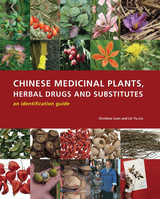
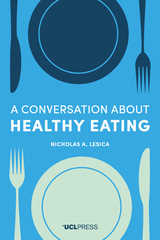
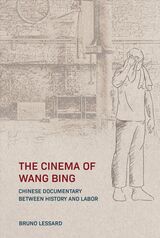
In The Cinema of Wang Bing, Bruno Lessard examines documentarian Wang Bing’s most important films. He focuses on the two obsessions at the heart of Wang’s oeuvre—the legacy of Maoist China in the present and the transformation of labor since China’s entry into the market economy—and how the crucial figures of survivor and worker are represented on screen. Bruno Lessard argues that Wang is a minjian (grassroots) intellectual whose films document the impact of Mao’s Great Leap Forward on Chinese collective memory and register the repercussions of China’s turn to neoliberalism on workers in the post-Reform era. Bringing together Chinese documentary studies and China studies, Lessard shows how Wang’s practice reflects the minjian ethos when documenting the survivors of the Great Famine and those who have not benefitted from China’s neoliberal policies—from laid-off workers to migrant workers. The films discussed include some of Wang’s most celebrated works such as West of the Tracks and Dead Souls, as well as neglected documentaries such as Coal Money and Bitter Money.

This ambitious study offers a panoramic survey of musical thought in the eighteenth century and, at the same time, a close analysis of the important theoretical topics of the period. The result is the most comprehensive account ever given of the theory behind the music of late Baroque and early Classical composers from Bach to Beethoven.
While giving preeminent theorists their due, Joel Lester also examines the works of over 100 seventeenth- and eighteenth-century writers to show how prominent theories were received and applied in actual teaching situations. Beginning with the influence of Zarlino and seventeenth-century theorists, Lester goes on to focus on central traditions emerging from definitive works in the early eighteenth century: species counterpoint in the writings of Fux; thoroughbass as presented by Niedt and Heinichen Rameau’s harmonic theories; and Mattheson’s views on melodic structure. The author traces the development and interactions of these traditions over the remainder of the century, through the writings of Albrechtsberger, C. P. E. Bach, Kirnberger, Koch, Marpurg, Martini, Nichelmann, Riepel, and many others. This historical overview is leavened throughout with accounts of individual composers grappling with theoretical issues—Haydn’s careful study of Fux’s treatise, Mozart’s instructions on harmony to his composition students, Beethoven’s own student exercises.
The links between various theoretical traditions, the pervasive influence of Rameau’s harmonic thinking, and the harmonic theories of Koch are just some of the numerous topics given their first full treatment here. Many of the theorists Lester cites are either unknown or often misunderstood today. By bringing their contributions to light and placing them within the context of theoretical tradition, Lester offers a fresh perspective, one that will inform and enhance any future study of this magnificent era in Western music.


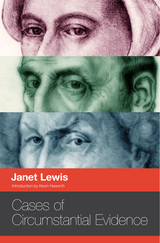
This is the first digital version of Cases of Circumstantial Evidence, a collection of three historical novels by noted American writer Janet Lewis. For the first time, these works have been brought together in a single edition, each with a new introduction by Kevin Haworth:
The Wife of Martin Guerre
Based on a notorious trial in sixteenth-century France, The Wife of Martin Guerre follows Bertrande de Rois and her lost-and-returned husband through a tale of impersonation, conspiracy, and small-town intrigue. Their fascinating story has also inspired a bestselling historical study and two films, including The Return of Martin Guerre.
The Trial of Sören Qvist
Although set in seventeenth-century Denmark, The Trial of Sören Qvist has a contemporary feel and has been praised for its intriguing plot and for Lewis’s powerful writing. In this second novel in the Cases of Circumstantial Evidence, Lewis recounts the story of a murder, an investigation, and a pious town pastor who confesses to the crime, driven perhaps more by a recognition of his own moral flaws than by guilt for the acts of which he stood accused.
The Ghost of Monsieur Scarron
The court of Louis XIV and a modest Paris street provide the incongruous settings for this tale of a humble bookbinder, his wife, and the young craftsman who seduces her and blackmails her husband into covering up a terrible crime. This third and last case of circumstantial evidence bristles with character, the smell of blood, and considerable suspense against a backdrop of national political unrest in the cruel and dingy Paris of the seventeenth century.

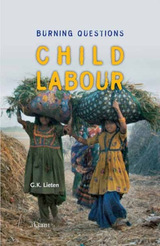
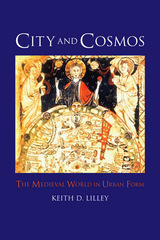
In City and Cosmos, Keith D. Lilley argues that the medieval mind considered the city truly a microcosm: much more than a collection of houses, a city also represented a scaled-down version of the very order and organization of the cosmos. Drawing upon a wide variety of sources, including original accounts, visual art, science, literature, and architectural history, City and Cosmos offers an innovative interpretation of how medieval Christians infused their urban surroundings with meaning.
Lilley combines both visual and textual evidence to demonstrate how the city carried Christian cosmological meaning and symbolism, sharing common spatial forms and functional ordering. City and Cosmos will not only appeal to a diverse range of scholars studying medieval history, archaeology, philosophy, and theology; but it will also find a broad audience in architecture, urban planning, and art history. With more of the world’s population inhabiting cities than ever before, this original perspective on urban order and culture will prove increasingly valuable to anyone wishing to better understand the role of the city in society.

Cinema without Reflection traces an implicit film theory in Jacques Derrida’s oeuvre, especially in his frequent invocation of the myth of Echo and Narcissus. Derrida’s reflections on the economies of image and sound that reverberate in this story, along with the spectral dialectics of love, mirrors, and poiesis, serve as the basis for a theory of cinema that Derrida perhaps secretly imagined.
Following Derrida’s interventions on Echo and Narcissus across his thought on the visual arts, Akira Mizuta Lippit seeks to return to a theory of cinema adrift in Derrida’s philosophy.
Forerunners is a thought-in-process series of breakthrough digital works. Written between fresh ideas and finished books, Forerunners draws on scholarly work initiated in notable blogs, social media, conference plenaries, journal articles, and the synergy of academic exchange. This is gray literature publishing: where intense thinking, change, and speculation take place in scholarship.


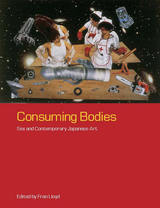
Sex and consumerism in art are inextricably linked to issues of power, gender, class and race, and move beyond the gallery into private and public realms, where the complex relationships surrounding sexuality and commerce are directly encountered in both the fast-changing marketplace and in the dominant ideologies within Japanese society.
With over 150 intriguing illustrations, Consuming Bodies provides a wide-ranging perspective on an under-researched area of contemporary Japanese art practice and the critical issues it uncovers.
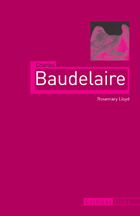
Lloyd argues that Baudelaire’s writings and life were intimately intertwined—and both were powerfully informed by contemporaneous political events, from his participation in the 1848 Revolution to the public morality codes that banned his controversial writings, such as Les fleurs du mal. The book traces the influence of these events and other political moments in his poems and essays and analyzes his works in this new light. Lloyd also examines the links between Baudelaire’s works and cultural movements of the time, from the rise and fall of Romanticism to symbolism, and explores his groundbreaking translations of Edgar Allan Poe’s writings into French.
Baudelaire’s tumultuous personal life figures large here, too, as Lloyd draws out fascinating aspects of his personality and daily life through analysis of archival writings of his friends and acquaintances. The book also documents his battles with syphilis and drug addiction, which ultimately resulted in his death. An engrossing and wholly readable biography, Charles Baudelaire will be essential for scholars and Baudelaire admirers alike.

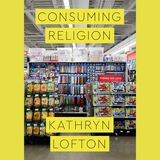
What are you drawn to like, to watch, or even to binge? What are you free to consume, and what do you become through consumption? These questions of desire and value, Kathryn Lofton argues, are questions for the study of religion. In eleven essays exploring soap and office cubicles, Britney Spears and the Kardashians, corporate culture and Goldman Sachs, Lofton shows the conceptual levers of religion in thinking about social modes of encounter, use, and longing. Wherever we see people articulate their dreams of and for the world, wherever we see those dreams organized into protocols, images, manuals, and contracts, we glimpse what the word “religion” allows us to describe and understand.
With great style and analytical acumen, Lofton offers the ultimate guide to religion and consumption in our capitalizing times.
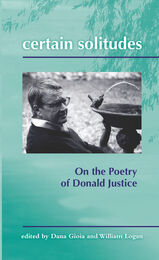

Context Providers explores the ways in which digital art and culture are challenging and changing the creative process and our ways of constructing meaning. The authors introduce the concept of artists as context providers—people who establish networks of information in a highly collaborative creative process, blurring boundaries between disciplines. Technological change has affected the function of art, the role of the artist, and the way artistic productions are shared, creating a need for flexible information filters as a framework for establishing meaning and identity. Context Providers considers the work of media artists today who are directly engaging the scientific community through collaboration, active dialogue, and creative work that challenges the scientific.
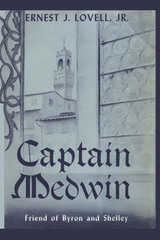
Here is the first biography of Thomas Medwin—literary adventurer, rascal, scholar, confidence man, successful fortune hunter, and bemused speculator on a grand scale in old Italian oil paintings. Poet, novelist, translator of Aeschylus, cousin and boyhood friend of the poet Shelley, he was a man of fiery temper, fierce hatreds, and enduring loves.
Although an intimate friend of Lord Byron, he was so dangerous (or disreputable) that his Lordship warned Teresa Guiccioli, his last mistress, not to be alone in Medwin's company. Later, Medwin introduced Byron's daughter to her future husband, Lord Lovelace, and so determined the poet's line of descent.
Friend of Washington Irving, gentleman of the old school, neglected Boswell of the nineteenth century, Medwin reported the conversations of Byron, Shelley, Trelawny, Hazlitt, Canova the sculptor, and others. His life and adventures light up little-known aspects of the nineteenth-century literary, military, social, and publishing world—in England, India, Italy, France, Switzerland, and Germany.
Medwin served as midwife to the words of a dead man—Lord Byron—who returned to laugh and sneer at the living from the Captain's pages. The Conversations of Lord Byron thus became the most controversial book of the day, going through a dozen editions, in six countries, and being translated into French, German, and Italian. It aroused the wrath, indignation, or enthusiastic interest of such individuals as Goethe, Lady Byron, Lady Caroline Lamb, the Countess Teresa Guiccioli, John Cam Hobhouse (later Lord Broughton), Sir Walter Scott, John Murray, and Washington Irving. Medwin, whose long and adventurous life extended from the rise and flowering of the Romantic Period to the mid-Victorian Age (which he regarded as a dreary decline from the great heights of his youth), was an influence of the first magnitude in determining the early public image of Byron and the reputation of Shelley.
This often amusing story, as engrossing as a novel, is drawn from all the available accounts, including many important sources never before published. In effect a new contribution to the biographical study of Byron and Shelley, it clarifies Medwin's relations not only with these two poets but also with many other important and interesting figures of the day.
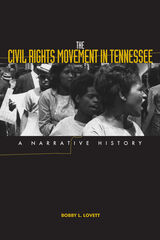

Lovins is President and founder of Natural Capitalism Solutions (NCS / www.natcapsolutions.org). NCS works with businesses, governments, and civil society to develop practices that are sustainable for both people and the environment. Her lecture focused on ways that the United States can pull itself out of the current recession, while preserving natural and human capital.
This E-ssential is an edited version of Lovins’ talk and the subsequent question and answer session. While some material has been cut and some language modified for clarity, the intention was to retain the substance of the original discussion.
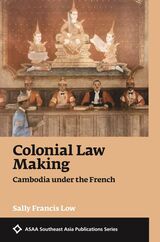
Covering a previously neglected area of Cambodian history, Colonial Law Making explores the structural forces and contingent exchanges that shaped colonial law in Cambodia and examines its post-independence colonial legacy.
The court of King Norodom and the temples of Angkor Wat became orientalist icons in the French colonial imagination, perpetuating an image of the Protectorate (1863–1953) as special and worthy of preservation. This contributed to exceptionalism in the way the Kingdom was colonized, including through law. Drawing on previously unexamined archival material, Sally Low presents a comparative case study of French approaches to colonial law, jurisdiction, and protection. Although the voices of non-elite Cambodians are largely absent from the archives, their influence on colonial law is evident as they resisted efforts to regulate their lives and their land. Low argues that the result was a set of state legal institutions and an indigenous jurisdiction that blended Cambodian and French notions of patronage and royal power as the source and authority for law.
This work is a case study of colonial law as an instrument of control and administration in an indirectly ruled colony. It adds depth to our understanding of the impact of European colonial law and the significance of different forms of colonial rule—direct, indirect, and unofficial. It is easily accessible for non-lawyers and is a must-read for those interested in the recent past of Southeast Asia and the countries that were previously colonized as French Indochina.

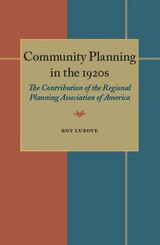

Epic history.
Lucan (M. Annaeus Lucanus, AD 39–65), son of wealthy M. Annaeus Mela and nephew of Seneca, was born at Corduba (Cordova) in Spain and was brought as a baby to Rome. In AD 60 at a festival in Emperor Nero’s honor Lucan praised him in a panegyric and was promoted to one or two minor offices. But having defeated Nero in a poetry contest he was interdicted from further recitals or publication, so that three books of his epic The Civil War were probably not issued in 61 when they were finished. By 65 he was composing the tenth book but then became involved in the unsuccessful plot of Piso against Nero and, aged only twenty-six, by order took his own life.
Quintilian called Lucan a poet “full of fire and energy and a master of brilliant phrases.” His epic stood next after Virgil’s in the estimation of antiquity. Julius Caesar looms as a sinister hero in his stormy chronicle in verse of the war between Caesar and the Republic’s forces under Pompey, and later under Cato in Africa—a chronicle of dramatic events carrying us from Caesar’s fateful crossing of the Rubicon, through the Battle of Pharsalus and death of Pompey, to Caesar victorious in Egypt. The poem is also called Pharsalia.
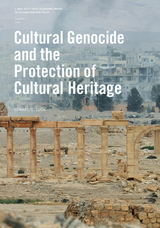
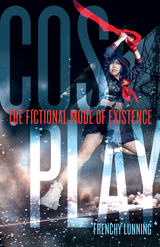
An exploration of cosplay and its relationship with the realms of its global fandom, performance, and the modes of fictional existence
Flourishing far beyond its Japanese roots, cosplay has become an international phenomenon with fervid fans who gather at enormous, worldwide conventions annually. Here, author Frenchy Lunning offers an intimate, sensational tour through cosplay’s past and present, as well as its global lure.
Through a culmination of years of personal research on cosplay, and growing out of Lunning’s wealth of scholarship, conference presentations, and cosplayer interviews, Cosplay is a unique and necessary examination of identity, performance, play, and otaku fandom and culture in relation to contemporary theories. With discussions covering construction, masquerades, and community through performance, Lunning presents cosplay as a dynamic and ever-evolving global practice. She combines the fascinating viewpoints of cosplayers with observational, in-depth research on cosplay history and practice, and a deep dive into critical theory involving the modes of fictional existence, in order to understand its global expansion.
Augmented with beautiful photographs, this is an engrossing, lively read that explores a complicated and often misunderstood history and meditates on how cosplay allows its participants to create and construct meaning and identity.
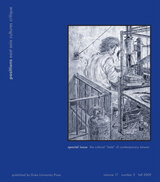
The seven essays in this issue represent a broad spectrum of academic approaches that include sociology, anthropology, legal studies, film studies, literary studies, and cultural theory. One essay investigates Taiwanese who have relocated to Shanghai in search of a secure economic future. Another uses psychoanalysis to examine potentially fascist representations of Taiwan in Japanese manga. The third essay addresses the legal status of women in Taiwan in various marital situations and historical periods. The fourth discusses literary representations of the juancun, or soldiers’ villages, which were common enclaves for retired military personnel and their families. Also featured in this issue are explorations of literary portrayals of the aftermath of the February 28, 1947, massacre and resulting White Terror events, as well as a consideration of the philanthropy practiced by the massive Ciji corporation, which holds more power in the world than Taiwan’s recognized government. The final essay offers a careful study of the films of Cai Mingliang and Chen Guofu and focuses on the way that contemporary Taiwanese cinema handles questions of consumer society, urban alienation, and sexual and emotional relationships.

A series of essays by internationally known artists, scholars, and critics in the growing field of cultural theory, Culture and Contestation in the New Century examines the conditions of cultural production in the first decade of the twenty-first century. With an emphasis on how current neoliberal policies have affected institutions of cultural production and dissemination, it emphasizes the ensuing changes to critical theory. The contributors here are among the most respected scholars in art, art criticism, and cultural studies, and this powerful analysis poses important questions about cultural democracy and social change.
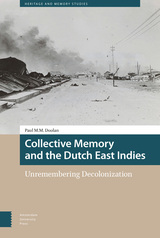

With methodological daring, Ma challenges existing scholarship by blending the professional and the personal through a lively and accessible autotheoretical approach. China Pop! walks the East-West cultural tightrope to critique a wide range of pop culture from both sides of the Pacific and sheds new light on the workings of propaganda on its intended audiences and its wider, more subtle reaches in both political and cultural spheres.

Located at the crossroads of fact and invention, docudrama constitutes a rich field of investigation for media studies. Despite the hybrid nature of this subject and a recent boom in podcasting, scholars have mainly concentrated on film rather than audio docufiction. Sabina Macchiavelli remedies this with an analysis of Italian and British docudramas that explores the ambiguities of this form, looking at their structure and form, as well as the type of understanding they convey. She investigates the ways that sound effects, music, recorded events, voices, and silence can work to fictionalize audio productions that sit somewhere between journalism and fully dramatized readings or plays. This interplay between fact, fiction, and sound subverts accepted knowledge and produces an alternative view of personal and historical matters, one that may complement or complicate the accepted version of the truth. Macchiavelli builds her case with studies from the British Broadcasting Corporation and the Radio Audizioni Italiane, tracing parallels and divergences within their programming to dig into the docudrama’s paradoxical nature and the ambiguities it yields.

Designed for undergraduate performance, Carnival Texts comprises three related dramatic works, all of which have as their point of departure Russian theorist Mikhail Bakhtin’s concept of carnival, a literary style designed to subvert dominant assumptions through chaos and humor. Making creative use of post-Brechtian performance theory, these texts blur the distinction between spectator and performer in a fascinating exploration of physical, moral, and cultural upheaval in a postmodern age. Performance theory is crucial to understanding how performance affects collective understanding, and this book will be of interest to a broad range of students of drama and theater.
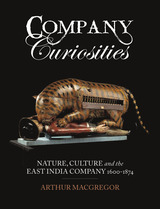
For a time, the East India Company’s own India Museum in London led the way in presenting their findings and establishing for a larger public the characteristic features of a subcontinent that would become the heart of Britain’s worldwide empire. Later, when the Great Exhibition and its successors redefined the style and the scale of presentation of the world’s commercial and industrial processes, the Company’s talented curators (now under their new masters, the India Office) continued to play a key role in articulating these materials. Meanwhile, Company employees returning from years of service diffused a taste for all things Indian. Superbly illustrated, Company Curiosities reveals how these diverse players invented the look and feel of India for those who had never ventured abroad.
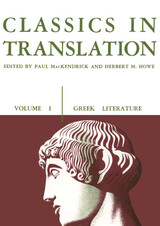
Here, translated into modern English, are the works of literature, history, science, oratory, and philosophy that constitute the mainstream of classical Greek thought and continue to influence world civilizations. This volume includes:
· Complete translations of Aeschylus’ Agamemnon, Sophocles’ Antigone, Euripides’ Medea, Aristophanes’ Frogs, and The Constitution of Athens by the “Old Oligarch.”
· Abridged translations of Homer’s Iliad and Odyssey, The Homeric Hymn to Hermes, and Plutarch’s Life of Tiberius Gracchus.
· Selections from Hesiod and Lucian; from twenty-eight lyric poets including Sappho, Pindar, and Meleagar; from the histories of Herodotus and Thucydides; and from eight Attic orators, including Isocrates and Demosthenes.
· Selections from the scientific writings of Hippocrates, Archimedes, and Galen.
· Selections from the pre-Socratic philosophers and from Plato, Aristotle, Epicurus, and Epictetus.
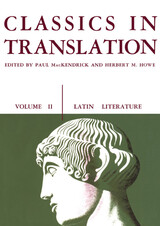
Here, translated into modern English, are the works of literature, history, science, oratory, and philosophy that constitute the mainstream of Roman thought and continue to influence world civilizations. This volume includes:
· Complete translations of Plautus’ The Haunted House, Terence’s Woman from Andros, Seneca’s Medea, and the Deeds of the Deified Augustus.
· Selections from Vergil’s Georgics and Aeneid, the poems of Catullus, Horace’s Odes, Ovid’s Metamorphoses and Fasti, the Satyricon of Petronius, and the Sixth Satire of Juvenal.
· Selections from Lucretius’ On the Nature of Things, Cicero’s speeches and philosophical works, and Quintilian’s The Training of the Orator.
· Selections from histories by Sallust, Livy’s History of Rome, Tacitus’ Annals and Germania, and letters of Pliny the Younger.
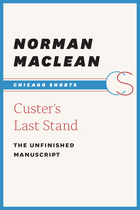
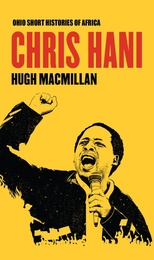
This biography shows how Black political leader Chris Hani’s life and death were pivotal to ending apartheid and to establishing a democratic government in South Africa.
Chris Hani is one of the most iconic figures in South Africa’s history, as a leader within the African National Congress (ANC) and as chief of staff of uMkhonto we Sizwe, the armed wing of the ANC. His assassination in 1993 by a far-right militant threatened negotiations to end apartheid and install a democratic government. Serious tensions followed the assassination, leading Nelson Mandela to address the nation in an effort to avert further violence:
Tonight I am reaching out to every single South African, black and white, from the very depths of my being. A white man, full of prejudice and hate, came to our country and committed a deed so foul that our whole nation now teeters on the brink of disaster. A white woman, of Afrikaner origin, risked her life so that we may know, and bring to justice, this assassin. The cold-blooded murder of Chris Hani has sent shock waves throughout the country and the world… Now is the time for all South Africans to stand together against those who, from any quarter, wish to destroy what Chris Hani gave his life for: the freedom of all of us.
Hugh Macmillan’s concise biography details Hani’s important role in shaping twentieth-century South African history.
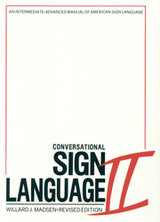
This book presents English words and their American Sign Language (ASL) equivalents in 63 lessons. Part one covers 750 words and their signs. Part two deals with the interpretation of 220 English idioms (which have over 300 usages in ASL). Part three presents over 300 ASL idioms and colloquialisms prevalent in informal conversations.
Conversational Sign Language II is excellent for the classroom or for self-instructional use and includes a separate index for each part as well as a bibliography. Each of the 63 lessons in the text is illustrated and has follow-up exercises. A practice test is included after every third lesson.
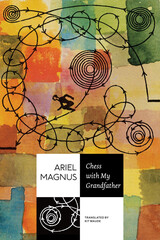
Ariel Magnus leaves no stone unturned in his efforts to learn more about his grandfather and the country to which he emigrated in the 1930s. Chess with My Grandfather is a playful, genre-shifting novel combining tales of international espionage, documentary evidence, and family lore. In this extraordinary book, Magnus blends fact and fiction in a delirious exploration of a dark period of history, family, identity, the power of art and literature and, of course, the fascinating world of chess.

The anthology challenges undifferentiated, stereotypical images of South Asians in North America, portraying instead the subtleties of their varied, sometimes invisible experiences. It includes fiction, poetry, essays, and photography.
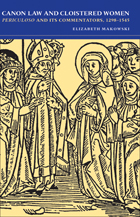
ABOUT THE AUTHOR: Elizabeth Makowski is associate professor of history at Southwest Texas State University. She is the coauthor of Wykked Wyves and the Woes of Marriage: Misogamous Literature from Juvenal to Chaucer (SUNY Press, 1989) and the author of numerous articles and book reviews. PRAISE FOR THE BOOK: "This is a significant contribution to the study of female monasticism. . . . Makowski's work is a welcome effort to understand the monastic discipline of enclosure and its application to convents. . . . What Makowski does in this fine study is to help scholars understand what [Periculoso] meant, both in the context in which it was fashioned and in the world of subsequent commentary. . . . An important book that should be required reading for all scholars of male and female monasticism."—Sixteenth Century Journal
"This is a clearly written survey of the decree and of medieval commentaries on it up to the Council of Trent. It will be of interest to historians both of legal and social history as well as throwing light upon the background of a much debated topic among religious orders."—English Historical Review "[The] work is well-written, contains helpful information on the topic in context, and should be a useful resource for those interested in this historical era as well as for those intrigued by the institutional Church's less than even-handed treatment of cloistered contemplative women through the centuries."—Studia Canonica "The clearly written survey of legal commentary on Periculoso is this book's greatest contribution. Even technical points of law are explained with sufficient clarity, so that the matters at issue can be understood even by one who is not a specialist in mediaeval canon law."—Ecclesiastical Law Journal
"This study provides insight into the way in which the leaders of the late medieval Church dealt with what they saw as the threat that women's spirituality posed to the Church and how to control it. To that extent alone, it is a valuable contribution to scholarship."—Catholic Historical Review
"Makowski has explored the comment

Makris engages the tumbura devotees of the area of Greater Khartoum in an animated discussion of their understanding of themselves and their world. Using oral histories, songs associated with the various spirits, and accounts of ceremonies he witnessed, he shows tumbura to be a response to victimization first in slavery and later by subordination. It functions as a counterdiscourse challenging the dominant discourse of the ex-slaveholding classes and enables its practitioners to assert a separate, alternative identity. This assertion, embodied in the idiom of possession, is achieved through a continuous reworking of meaning as it is imparted by religion, descent, and historical consciousness.

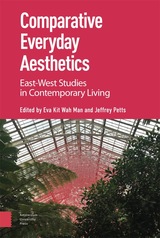



The Celebrity Persona Pandemic explores how the construction of a public persona is fetishized in contemporary culture. As social media has progressively led to a greater focus on the production of the self, so this book looks at the most visible versions of persona through figures such as Stephen Colbert, Cate Blachett, and Justin Bieber, as well as fictional characters like Spock and Harry Potter. Ultimately, P. David Marshall closely studies how persona culture shapes our notions of value and significance, and dramatically shifts cultural politics.
Forerunners is a thought-in-process series of breakthrough digital works. Written between fresh ideas and finished books, Forerunners draws on scholarly work initiated in notable blogs, social media, conference plenaries, journal articles, and the synergy of academic exchange. This is gray literature publishing: where intense thinking, change, and speculation take place in scholarship.
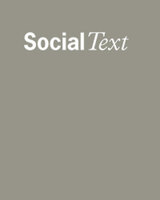
Addressing several recent high-profile scandals, contributors examine both the short- and the long-term ramifications of corporate corruption: the means by which Martha Stewart has been used as an icon and a scapegoat in the ImClone case while broader critical issues have failed to receive the attention they demand; the divisive ways in which the antifeminist Independent Women’s Forum—along with other neocon organizations and pundits—has moved the debate regarding the deregulation of the financial services sector far to the right of the far right; the collapse of Enron and what it means for corporate governance; the global implications of U.S. corporate corruption; the confusion over public and private business transactions in Argentina; the moral panic ensuing from the random violence caused by the Washington, D.C. area snipers precisely as the U.S. was launching a war on Iraq because of its supposed weapons of mass destruction; and the emergence of a new business model and icon, the hiphop mogul.
Contributors. Peter Bratsis, David M. Brennan, Jane Marcus-Delgado, Randy Martin, Nancy Shaw, Ella Shohat, Christopher Holmes Smith, Barbara Spindel, Susan Willis
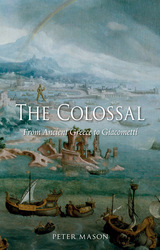
Combining fascinating detail with a rigorous account that spans three millennia, The Colossal argues that the artist who best understood and tapped into the kolossos was Alberto Giacometti. Mason shows that the Swiss sculptor and painter’s work articulated themes of death and mourning in ways rarely seen since the art of archaic Greece, themes most evident in his enigmatic work, The Cube. From the monolithic sculptures of long-dead civilizations to Giacometti’s imposing and unsettling heads, The Colossal is an innovative book that traces unexplored thematic threads through visual history.
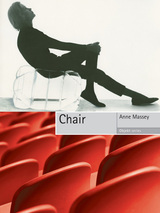
The chair—you’re likely sitting in one right now. Yet, despite its common presence in offices, restaurants, and homes, we very rarely stop to think about the origins of the chair and its place in culture. After all, the human body is actually more suited to sitting on the ground than on a chair; and as a result, chairs often cause back problems. Nonetheless, in Western culture, as Anne Massey explains, the chair is an object that marks our place in the modern world.
Massey explores how, particularly in the last hundred years, the chair has become a revered object of design. Certain chairs have become iconic—like the Eames Lounge chair and Verner Panton’s S Chair, which are photographed, exhibited in art museums, and slavishly copied by cheaper models. Other chairs have reached iconic status simply through their everydayness—think of Van Gogh’s chair or the way Shaker chairs have become emblematic of a simpler and purer lifestyle. Massey further examines how chairs have been crafted, from local to global manufacture. In doing so she elucidates the meaning of the chair in contemporary culture, as well as the development, design, and manufacture of this ubiquitous object.
Drawing on design, art, popular culture, and personal experience, Chair is an engaging and informative biography of this everyday object and will appeal to anyone interested in why we choose to sit on the chairs we do.
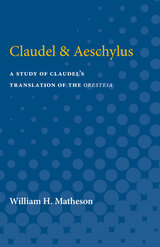
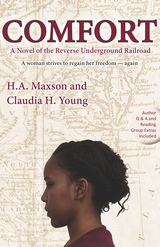

Cedrick May’s The Collected Works of Jupiter Hammon offers a complete look at the literary achievements of one of the founders of African American literature. Born into slavery on the Lloyd plantation in 1711, Jupiter Hammon became the first African American writer to be published in the present-day United States at the age of forty-nine. It has been decades since a collection of Hammon’s work has appeared, and May’s intensive research has yielded two additional poems, adding new layers to his works and life that, until now, have gone unexplored.
The most comprehensive volume on Hammon’s works to date, The Collected Works of Jupiter Hammon carefully reconstructs the historical, political, social, and religious contexts that shaped his essays and poems throughout the late eighteenth century. This attentive reconstruction, which takes full account of Hammon’s prose works as well as his more well-known poetry, gives readers a radical re-reading of Hammon as a much more complex and intellectually curious commentator on his historical and political period, while providing ample evidence of his literary importance and artistic integrity. Cedrick May’s fresh presentation and insightful reevaluation of Hammon’s life and writings will change the way Hammon is studied and appreciated among literary scholars and readers alike. This edition will become the definitive one for many years to come.
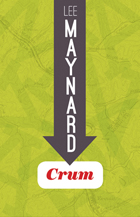
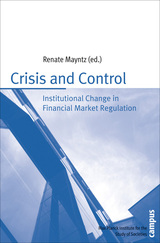
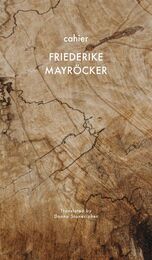
Friederike Mayröcker has no time. Not for summary and memory, not for excessive reviewing and reasoning, and certainly not for storytelling. She doesn’t even have time for life itself—unless it’s writing. What counts, in her view, is only the poetry and “the echoic inventions” of a life that lasted for almost a century, which is preserved in her writings.
Widely considered one of the most important European poets of the twentieth and twenty-first centuries, Mayröcker passed away in 2021 at the age of ninety-six. On the outside, her life may be subject to the impertinence of the finitude of all human existence. But on the inside, and in its transformation into the eternal moment, life only becomes richer and richer in forms of experience. In radically concentrated language and compellingly beautiful images, Mayröcker presents in this cahier a life that follows only one maxim: “Not just what is written, but existence, too, must be poetic.”
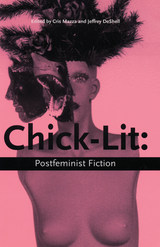
Chick-Lit: Postfeminist Fiction is the fourth volume in “On the Edge: New Women’s Fiction,” FC2’s ongoing effort to discover new and innovative voices in women’s fiction. Determined to contradict the myth that “women don't write experimental fiction,” Chick-Lit discovers women writers with a fresh and irreverent wit and honesty, but no less powerful in their rendering of human experience.
Chick-Lit collects the original fiction of newly discovered writers, but also the award winning work of notable writers like Carole Maso, Jonis Agee, Stacy Levinne and Carolyn Banks. Marked by innovations in form and point-of-view, the writers in this collection are not satisfied with the terrain commonly referred to as “women’s writing.” Insane asylum sex, board games that control people’s lives, a masochistic pedophile humiliated by his victim, an obese woman paying nickels and quarters for attention from teenage girls, a deranged hair stylist and her disloyal dog, a men's impotence therapy group, a surreal landscape constantly producing the body of a woman's mother: this is writing that shouts, yes, there is such a thing as postfeminist fiction.
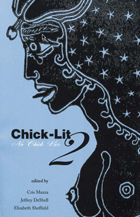
Chick-Lit 2: No Chick Vics features new work by Rikki Ducornet, Eurydice, Elizabeth Graver, Ursule Molinaro, and fourteen other witty and deadly serious writers.
Chick-Lit 2 discovers new and alternative voices in women’s fiction whose stories do not involve trauma that comes from the outside. As Mazza writes in her introduction, “Sexual assaults and harassments and injurious poor body images do exist and have waged a war on women (the American Medical Association says so). But for this book, I was interested in seeing what action(s) women characters can incite on their own, whether bad or good, hopeful or dead-end, progressive or destructive.”
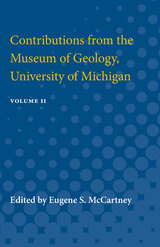
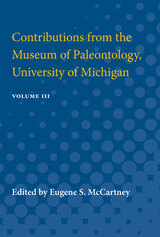
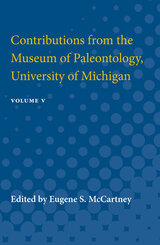
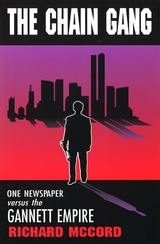
"They're closing in on me, Dick, and I'm afraid they're going to get me," said Frank Wood, publisher of the Green Bay News-Chronicle, in a phone call to his friend and colleague, Richard McCord. Drained of cash and spirit, Wood could not hold out much longer against a devouring giant, the Gannett Company. As editor and publisher of the nationally distinguished weekly Santa Fe Reporter, McCord had successfully fended off Gannett's "Operation Demolition" when it moved into town. Now Wood was seeking the help of a survivor.
Startling case histories of the dubious tactics practiced by Gannett, unsparing insights into the newspaper industry, and harsh conclusions all come together in the dramatic story of these two men's efforts to save the small Green Bay daily from being obliterated at the hands of the nation's largest newspaper chain. Their success is a metaphor for one of the oldest triumphs of the world: that of David over Goliath.
"McCord has done something marvelous with this. He's taken a deeply disturbing nationwide trend and put it on a small midwestern stage with real characters. The Chain Gang's message needs to be heard by as many Americans as read newspapers. Already Gannett's monopoly tactics have impoverished communities across the country. McCord is one man fighting back, coolly, rationally, creatively, and stubbornly. Let's join him."—Michael Shnayerson, Contributing Editor, Vanity Fair
"More graphically than almost any other available record of the era, the Gannett piracy is what has happened to this country, tolled where the price is truly paid, in the lives of communities and people."—Roger Morris, winner of the Investigative Reporters and Editors' National Award for Distinguished Investigative Journalism
"Richard McCord's The Chain Gang takes the losing battle for the soul of American newspapers from the euphoric accounts on financial pages to show what corporate news chains can mean in human terms to the people and the vitality of the victimized cities and towns. His is a unique account of the power and depredations of the Gannett Chain under its glib empire builder, Allen Neuharth. It goes behind the facade of slick public relations and financial killings for investors to show what happens when a ruthless and ambitious wheeler-dealer gets control of our news."—Ben H. Bagdikian, media critic and Pulitzer Prize winner
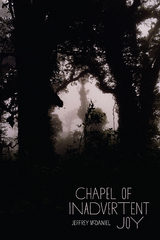
“Reading Jeffrey McDaniel’s gorgeously dark and utterly compelling Chapel of Inadvertent Joy reminds me that he is probably the most important poet in America. The book in your hands was written by a master of metaphor and a poet of huge imagination and fierce ingenuity, a fine antidote to realism. Get this voice in your head.”
—Major Jackson

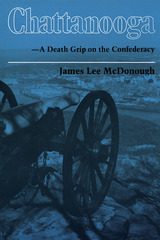

Caroline Gordon - American Writers 59 was first published in 1966. Minnesota Archive Editions uses digital technology to make long-unavailable books once again accessible, and are published unaltered from the original University of Minnesota Press editions.
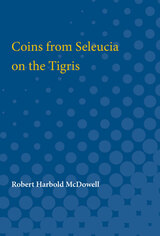
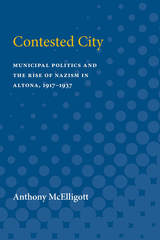
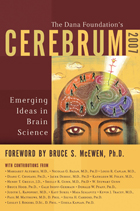
New advances are being made in brain science today that will directly affect each of our lives, from the courtroom to the classroom to the living room. Cerebrum has long been the leading journal in distilling these developments in neuroscience for the general reader, and its articles by leading scientists and scholars are cited in such prominent publications as the Wall Street Journal, Boston Globe, and Washington Post. Collected here are over a dozen articles and book reviews from the journal’s online edition about the latest developments in brain science.
The featured articles offer thought-provoking analyses of the human brain and its untapped possibilities, touching on topics as diverse as the neurological basis for a belief in the supernatural, the use of drugs to alter traumatic memories, and the biological nature of ethical behavior. Top scientists and scholars—including neurologist Dr. Kathleen Foley, of Memorial Sloan-Kettering Cancer Center; Henry T. Greely, bioethicist and Stanford University professor of law; and Dr. Judith L. Rapoport, chief of the child psychiatry branch at the National Institute of Mental Health— clearly and concisely explain these and many other exciting developments on the horizon. An engaging and wholly readable compendium, Cerebrum 2007 is essential for all those interested in the cutting edge of brain research and what it holds for the future of humanity.
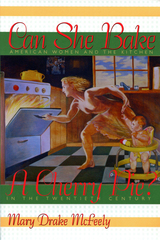
This book shows how cooking developed and evolved during the twentieth century. From Fannie Farmer to Julia Child, new challenges arose to replace the old. Women found themselves still tied to the kitchen, but for different reasons and with the need to acquire new skills. Instead of simply providing sustenance for the family, they now had to master more complex cooking techniques, the knowledge of "ethnic" cuisines, the science of nutrition, the business of consumerism, and, perhaps most important of all, the art of keeping their husbands and children happy and healthy.

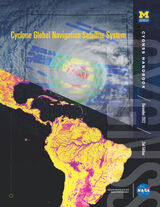

Cosmopolitan Imaginaries and International Disorder argues that advocacy for cosmopolitan order reform in the modern world has struggled to recognize the political identities of states and populations and to legitimize its proposed political hierarchies. As a result, these efforts have been overwhelmed by states shoring up their power and remobilizing exclusionary nationalist identities, especially when struggles are intensified in contexts of international instability and economic turmoil. In developing a theory to explain these patterns of cosmopolitan politics, this book offers insight into the limits and role of cosmopolitanism in a dividing international order after liberal globalism.

Cloning was first published in 1985. Minnesota Archive Editions uses digital technology to make long-unavailable books once again accessible, and are published unaltered from the original University of Minnesota Press editions.
Cloning has become in recent years a subject of widespread speculation: the word is a source of fear and wonder, the concept a jumping-off point for the fantasies of cartoonists, film producers, and novelists. With this book, cell biologist Robert Gilmore McKinnell provides the first clear scientific explanation of the procedure for general readers.
Cloning is best defined as the asexual reproduction of genetic duplicates. The word clone derives from the Greek word for a twig or a slip, and the first "cloners" were in fact horticulturalists. Early attempts to clone animals culminated in 1952 when biologists reported that they had produced frogs by transplanting genetic material from an embryonic body cell into an egg from which the nucleus had been removed.
In this account, McKinnell traces the historical background of cloning and describes in detail the modern procedure used in the cloning of frogs—the highest animal thus far cloned. He emphasizes that the purpose of cloning is not to produce numerous frogs—or people—but rather to serve as a tool in biological research—to achieve greater understanding of cancer and aging, immunobiology and the differentiation of cells.
McKinnell also deals with questions about potential mammalian clones and examines the social, ethical, and biological problems we face in our considerations about human cloning. He concludes that human clones are not necessary for research purposes and that the diversity achieved with sexual reproduction is far more desirable than the sameness of cloned creatures.
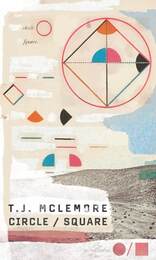
READERS
Browse our collection.
PUBLISHERS
See BiblioVault's publisher services.
STUDENT SERVICES
Files for college accessibility offices.
UChicago Accessibility Resources
home | accessibility | search | about | contact us
BiblioVault ® 2001 - 2024
The University of Chicago Press


